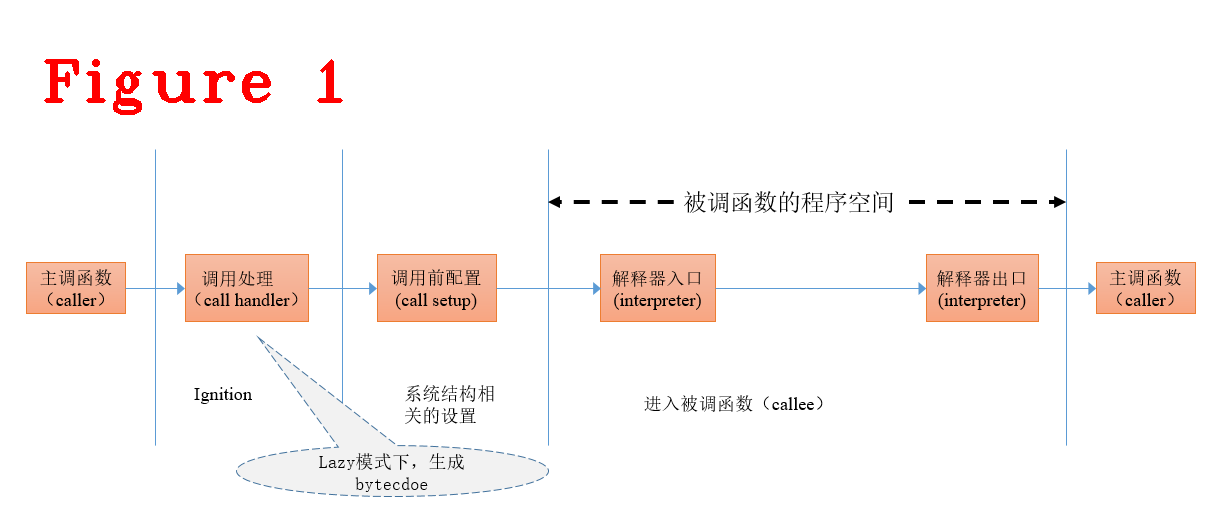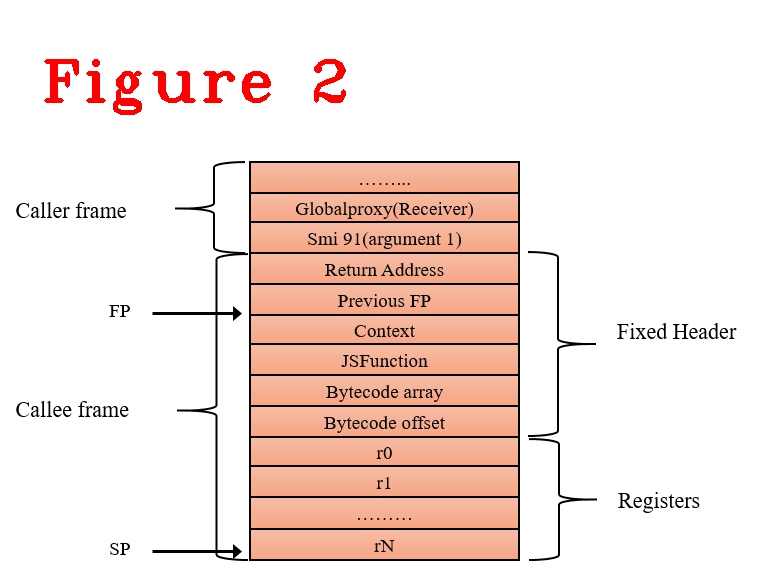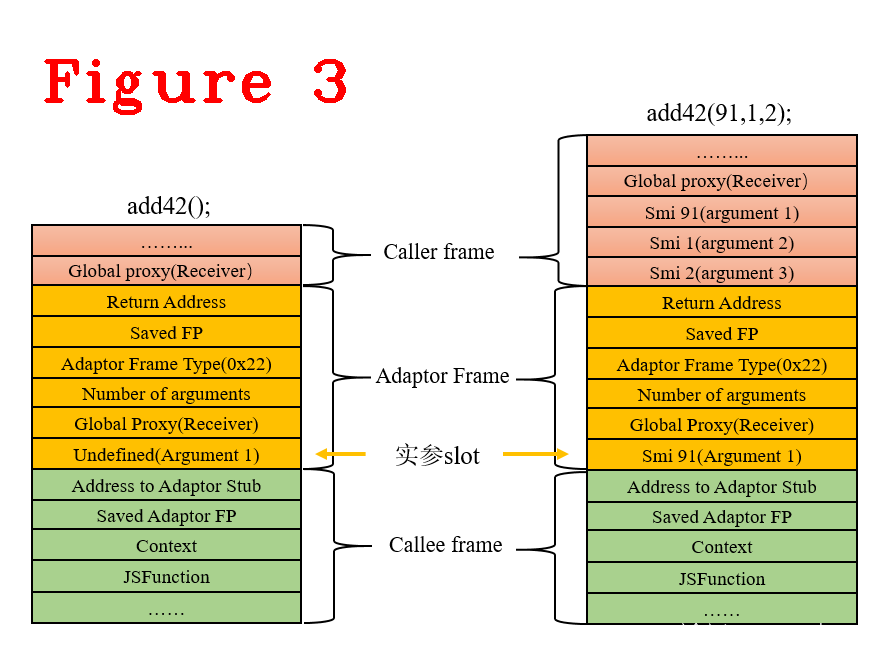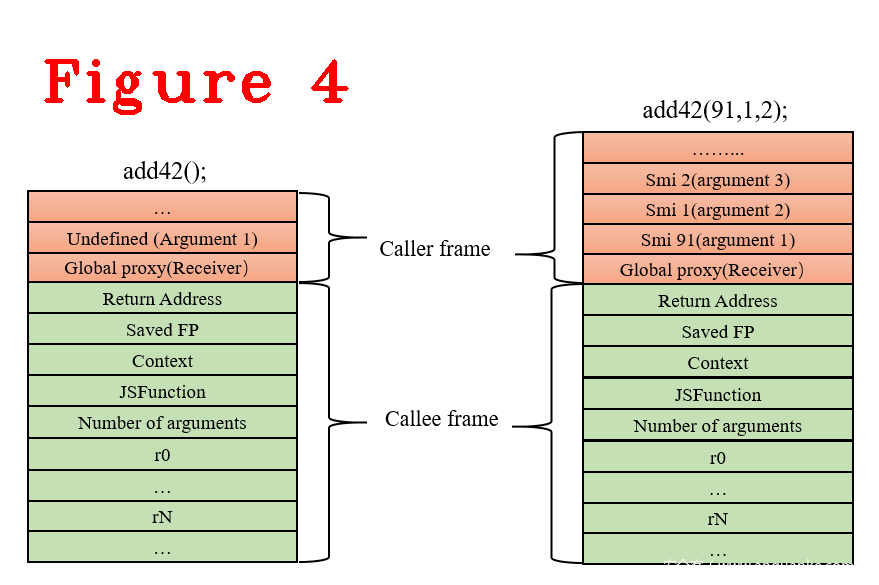连载《Chrome V8 原理讲解》第七篇 V8堆栈框架 Stack Frame
连载《Chrome V8 原理讲解》第七篇 V8堆栈框架 Stack Frame

1 摘要
本文是第七篇。讲解v8处理函数调用时的底层架构。通过分析运行时函数堆栈,重点对“实际参数少于声明参数”和“实际参数多于声明参数”两种函数调用的stack frame进行详细分析,解释这两种调用方式为什么没有发生堆栈泄露,还能稳定运行、生成正确结果的原因,借此阐述v8堆栈的设计细节。
本文中把“实际参数少于声明参数”和“实际参数多于声明参数”称为实参不匹配,“实参与函数声明的形参数量相同”称为正常调用。本文的组织方式:v8 stack frame介绍(章节2);stack frame的先导知识—寄存器与参数编码(章节3);v8刚淘汰的adaptor frame机制(章节4);v8最新的stack frame机制(章节5)。
关键词:stack frame,caller,callee,bytecode,adaptor frame
2 stack frame介绍
v8在调用函数(callee)之前都会把实际参数压栈,callee会把局部变量压栈。stack frame是一块保留区域,用于存放实参、callee的返回值、局部变量和寄存器。stack frame的创建步骤如下:
(1) callee的实际参数。如果有,压栈。
(2) callee的返回地址压栈。
(3) callee开始执行,EBP压栈。
(4) 设置EBP等于ESP。注:EBP现在代表callee的栈基址。
(5) 如果有局部变量,修改ESP预留栈空间。
(6) 如果需要保存寄存器,压栈。
以上六步是常规的函数调用堆栈构建过程,看下面的样例代码,是正常的函数调用。
function add42(x) {
return x + 42;
}
add42(91);
add42(x)在V8中的执行过程如图1所示。注:不考虑优化技术

图1中,在lazy mode(相关概念参见第五篇文章)情况下,当callee初次执行时,Ignition才生成它的bytecode,安装与体系结构相关的配置,进入callee空间执行,最后再返回到caller。bytecode生成后,开始执行add42(x),stack frame如图2。

图2是callee执行时的stack frame,构建过程由V8中的InterpreterPushArgsThenCall负责,add42(x)定义时声明了一个参数,调用时也是传入了一个实参91,这是一个正常的函数调用,调用结束后正常退出,正常清理堆栈。看下面两种非常普遍的情况:
(1) 调用函数不传实参,add42()
(2) 调用函数传入多个实参,add42(91,1,2)
这两种情况属于“实参不匹配”,在sloppy mode下不会报错,正常执行,add42(91,1,2)还会返回正确的结果133。众所周知,“实参不匹配”时,calee退出时可能发生堆栈泄露。本文剩余篇幅讲解V8如何做到“实参不匹配”的正确运行,既能有正确的返回结果(133),又不发生堆栈泄露。
3 寄存器与参数编码
了解bytecode中寄存器和函数参数的编码方式,有助于理解stack frame的原理。调用add42(91)生成的bytecode如下:
0d LdaUndefined //加载undefined到累加器
26 f9 Star r2 //累加器的值存入r2寄存器
13 01 00 LdaGlobal [1] //加载全局指针(add42)到累加器
26 fa Star r1 //累加器的值存入r1
0c 03 LdaSmi [91] //加载小整型数91到累加器
26 f8 Star r3 //累加器的值存入r3
5f fa f9 02 CallNoFeedback r1, r2-r3 //调用add42(x)
寄存器用非负单字节整数编码,r1的编码是fa,r2是f9,以此类推。5f fa f9 02 CallNoFeedback r1, r2-r3中,fa代表r1寄存器,f9代表r2寄存器,02表示长度为2,f9 02联合表示:以r2开始,长度为2的寄存器列表。
25 02 Ldar a0 //加载第一个参数到累加器
40 2a 00 AddSmi [42] //累加器 +=42
ab Return //返回累加器
上面是执行add42(x)函数的bytecode,第一个参数(a0)的数字编码是02。
这种编码其实是stack frame的偏移量,见图2,fa补码(two’s complement)是6,FP减6正好是r1寄存器,a0补码是2,FP加2正好是第一个实参91。这种编码方式的优点:通过简单的FP加减操作,实现了对参数和寄存器的快速访问,简化了字节码的设计。注意: 由于v8版本更新迭代快,不同版v8的编码实现存在细微差别,但编码思路是相同的,并且v8中规定了寄器存访问公式:r[i]=FP-2-kFixedFrameHeaderSize-i,参数访问公式:a[i]=FP+2+parameter_count-i-1,parameter_count表示参数的数量。
4 adaptor frame机制
沿用多年的adaptor frame机制已经被淘汰,但了解adaptor frame机制,有助理解v8中新stack frame机制的原理和设计初衷。下面是“实参不匹配”的调用:
add42()
add42(91,1,2,)
众所周知,add42()的结果是undefined+42=NaN;add42(91,1,2)的结果是91+42=133;这两个函数都正常执行,没发生堆栈泄露,并且返回结果133,图3给出了stack frame的镜像。

与图2对比,可知stack frame中新增了adaptor frame结构(黄色标记)。adaptor frame中有两个重要数据:
(1)Number of arguments,它记录了add42(x)调用时的参数数量。这个数值在编译期,通过查询对应的JSFunction获得,对于add42(x),它的值为1。
(2)实参slot,存储了add42(x)调用时传入的实参,数量由Number of arguments决定。
在执行add42()时,缺少一个实参,用一个Undefined填充实参slot,见图3中左侧的stack frame。
另一个add42(91,1,2)中,虽然入栈三个实数,但根据Number of arguments得知,只需要一个实参,取第一个参数91填充实参slot。
之后,进入add42(x)开始执行,它所需要的实数从Adaptor Frame中读取的,和Caller Frame没有关系。add42(x)执行时可以准确地读取实数,Undefinded或91,这变成了正常调用。
总结,Adaptor Frame的作用是改变“实参不匹配”为“正常调用”,其本质是caller和callee之间的纽带,负责计算存callee所需要的实参,并从caller中取来,缺失时用undefined补上,多余的忽略。入压时已经保存了Saved FP和Saved Adaptor FP,callee退栈到Adaptor Frame,Adaptor Frame退栈到caller,所以不会发生堆栈泄露。
为什么v8淘汰Adaptor Frame?因为性能损耗,调用一次callee,要发生两次stack Frame构建,一次是构建Adaptor Frame,另一次是构建callee Frame,这是很耗时的,所以要淘汰。
5 最新的stack frame机制
出于性能优化的考虑,2021年初,服役多年的adaptor frame退出了历史舞台,新版stack frame机制如图4所示。

它的创新点是省去adaptor frame,将函数调用时的堆栈构建减少一次,但保留Number of Arguments。
新版stack frame机制必须满足以下四点要求,这更是v8团队设计这种新stack frame机制的初衷:
(1) 满足章节2中介绍的用偏移量访问参数和寄存器的方式。
(2) 必须能处理“实参不匹配”的函数调用,add42()和add42(91,1,2)都可以正常执行。
(3) callee退出,实现堆栈正常清理,这是必须的!
(4) 抛弃adaptor frame,因为它太消耗性能。
下面详细说明图4的新stack frame机制如何满足以上四点要求:
针对第(1)点要求,入压方式不变,编码方式不变,一定满足,读者可以计算验证,不再赘述。
针对第(2)点要求,Number of arguments的作用与上面的一样,记录callee需要的实参数量,add42(x)的Number of arguments是1。v8约定:callee的实参由右向左压入caller Frame,压入数量取实际数量和Number of arguments的最大值。add42(91,1,2)调用时,实际数量是3(91,1,2)个,入栈3个实参,依次为2,1,91。add42()调用时,实际数量是0个,Number of arguments是1,要入栈1个实参,用Undefined填充。进入add42(x)执行,它可以得到期望的参数(91或Undefined),此需求满足。
针对第(3)点要求,图4中入栈方式是常规的入栈,所以退出时不存在任何问题。
针对第(4)点要求,已经满足了,adaptor frame suddenly disappeared!!!
下面给出上述功能的关键入口函数,供读者复现学习。
void Builtins::Generate_InterpreterPushArgsThenCallImpl(
MacroAssembler* masm, ConvertReceiverMode receiver_mode,
InterpreterPushArgsMode mode) {
DCHECK(mode != InterpreterPushArgsMode::kArrayFunction);
// ----------- S t a t e -------------
// -- rax : the number of arguments (not including the receiver)
// -- rbx : the address of the first argument to be pushed. Subsequent
// arguments should be consecutive above this, in the same order as
// they are to be pushed onto the stack.
// -- rdi : the target to call (can be any Object).
// -----------------------------------
Label stack_overflow;
if (mode == InterpreterPushArgsMode::kWithFinalSpread) {
// The spread argument should not be pushed.
__ decl(rax);
}
__ leal(rcx, Operand(rax, 1)); // Add one for receiver.
// Add a stack check before pushing arguments.
__ StackOverflowCheck(rcx, &stack_overflow);
// Pop return address to allow tail-call after pushing arguments.
__ PopReturnAddressTo(kScratchRegister);
if (receiver_mode == ConvertReceiverMode::kNullOrUndefined) {
// Don't copy receiver.
__ decq(rcx);
}
// rbx and rdx will be modified.
GenerateInterpreterPushArgs(masm, rcx, rbx, rdx);
// Push "undefined" as the receiver arg if we need to.
if (receiver_mode == ConvertReceiverMode::kNullOrUndefined) {
__ PushRoot(RootIndex::kUndefinedValue);
}
if (mode == InterpreterPushArgsMode::kWithFinalSpread) {
// Pass the spread in the register rbx.
// rbx already points to the penultime argument, the spread
// is below that.
__ movq(rbx, Operand(rbx, -kSystemPointerSize));
}
// Call the target.
__ PushReturnAddressFrom(kScratchRegister); // Re-push return address.
if (mode == InterpreterPushArgsMode::kWithFinalSpread) {
__ Jump(BUILTIN_CODE(masm->isolate(), CallWithSpread),
RelocInfo::CODE_TARGET);
} else {
__ Jump(masm->isolate()->builtins()->Call(receiver_mode),
RelocInfo::CODE_TARGET);
}
// Throw stack overflow exception.
__ bind(&stack_overflow);
{
__ TailCallRuntime(Runtime::kThrowStackOverflow);
// This should be unreachable.
__ int3();
}
}
//=======================================
//======分割线==========================
//=======================================
void Builtins::Generate_InterpreterPushArgsThenConstructImpl(
MacroAssembler* masm, InterpreterPushArgsMode mode) {
// ----------- S t a t e -------------
// -- rax : the number of arguments (not including the receiver)
// -- rdx : the new target (either the same as the constructor or
// the JSFunction on which new was invoked initially)
// -- rdi : the constructor to call (can be any Object)
// -- rbx : the allocation site feedback if available, undefined otherwise
// -- rcx : the address of the first argument to be pushed. Subsequent
// arguments should be consecutive above this, in the same order as
// they are to be pushed onto the stack.
// -----------------------------------
Label stack_overflow;
// Add a stack check before pushing arguments.
__ StackOverflowCheck(rax, &stack_overflow);
// Pop return address to allow tail-call after pushing arguments.
__ PopReturnAddressTo(kScratchRegister);
if (mode == InterpreterPushArgsMode::kWithFinalSpread) {
// The spread argument should not be pushed.
__ decl(rax);
}
// rcx and r8 will be modified.
GenerateInterpreterPushArgs(masm, rax, rcx, r8);
// Push slot for the receiver to be constructed.
__ Push(Immediate(0));
if (mode == InterpreterPushArgsMode::kWithFinalSpread) {
// Pass the spread in the register rbx.
__ movq(rbx, Operand(rcx, -kSystemPointerSize));
// Push return address in preparation for the tail-call.
__ PushReturnAddressFrom(kScratchRegister);
} else {
__ PushReturnAddressFrom(kScratchRegister);
__ AssertUndefinedOrAllocationSite(rbx);
}
if (mode == InterpreterPushArgsMode::kArrayFunction) {
// Tail call to the array construct stub (still in the caller
// context at this point).
__ AssertFunction(rdi);
// Jump to the constructor function (rax, rbx, rdx passed on).
Handle<Code> code = BUILTIN_CODE(masm->isolate(), ArrayConstructorImpl);
__ Jump(code, RelocInfo::CODE_TARGET);
} else if (mode == InterpreterPushArgsMode::kWithFinalSpread) {
// Call the constructor (rax, rdx, rdi passed on).
__ Jump(BUILTIN_CODE(masm->isolate(), ConstructWithSpread),
RelocInfo::CODE_TARGET);
} else {
DCHECK_EQ(InterpreterPushArgsMode::kOther, mode);
// Call the constructor (rax, rdx, rdi passed on).
__ Jump(BUILTIN_CODE(masm->isolate(), Construct), RelocInfo::CODE_TARGET);
}
// Throw stack overflow exception.
__ bind(&stack_overflow);
{
__ TailCallRuntime(Runtime::kThrowStackOverflow);
// This should be unreachable.
__ int3();
}
}
以上代码是两功能函数,给出了即将执行callee之前,做的一些与体系结构相关的准备工作,我的平台是x64架构,所以上述代码取自builtins-x64.cc,读者可以debug调式学习。
void Builtins::Generate_Call(MacroAssembler* masm, ConvertReceiverMode mode) {
// ----------- S t a t e -------------
// -- rax : the number of arguments (not including the receiver)
// -- rdi : the target to call (can be any Object)
// -----------------------------------
StackArgumentsAccessor args(rax);
Label non_callable;
__ JumpIfSmi(rdi, &non_callable);
__ LoadMap(rcx, rdi);
__ CmpInstanceTypeRange(rcx, FIRST_JS_FUNCTION_TYPE, LAST_JS_FUNCTION_TYPE);
__ Jump(masm->isolate()->builtins()->CallFunction(mode),
RelocInfo::CODE_TARGET, below_equal);
__ CmpInstanceType(rcx, JS_BOUND_FUNCTION_TYPE);
__ Jump(BUILTIN_CODE(masm->isolate(), CallBoundFunction),
RelocInfo::CODE_TARGET, equal);
// Check if target has a [[Call]] internal method.
__ testb(FieldOperand(rcx, Map::kBitFieldOffset),
Immediate(Map::Bits1::IsCallableBit::kMask));
__ j(zero, &non_callable, Label::kNear);
// Check if target is a proxy and call CallProxy external builtin
__ CmpInstanceType(rcx, JS_PROXY_TYPE);
__ Jump(BUILTIN_CODE(masm->isolate(), CallProxy), RelocInfo::CODE_TARGET,
equal);
// 2. Call to something else, which might have a [[Call]] internal method (if
// not we raise an exception).
// Overwrite the original receiver with the (original) target.
__ movq(args.GetReceiverOperand(), rdi);
// Let the "call_as_function_delegate" take care of the rest.
__ LoadNativeContextSlot(rdi, Context::CALL_AS_FUNCTION_DELEGATE_INDEX);
__ Jump(masm->isolate()->builtins()->CallFunction(
ConvertReceiverMode::kNotNullOrUndefined),
RelocInfo::CODE_TARGET);
// 3. Call to something that is not callable.
__ bind(&non_callable);
{
FrameScope scope(masm, StackFrame::INTERNAL);
__ Push(rdi);
__ CallRuntime(Runtime::kThrowCalledNonCallable);
}
}
本文只讲解callee为函数的情况(根据ECMA规范,callee还可以是构造体,等等。),此时上述代码是执行callee的入口函数,Generate_Call的第一个参数MacroAssembler* masm以及它内部的指令,如__ JumpIfSmi(rdi, &non_callable);都说明了这里执行bytecode,读者可以自行debug调试。
从这里开始,后续会用到汇编知识,经常在没有源码的情况下进行汇编调试。
好了,今天到这里,下次见。
恳请读者批评指正、提出宝贵意见
微信:qq9123013 备注:v8交流 邮箱:v8blink@outlook.com
